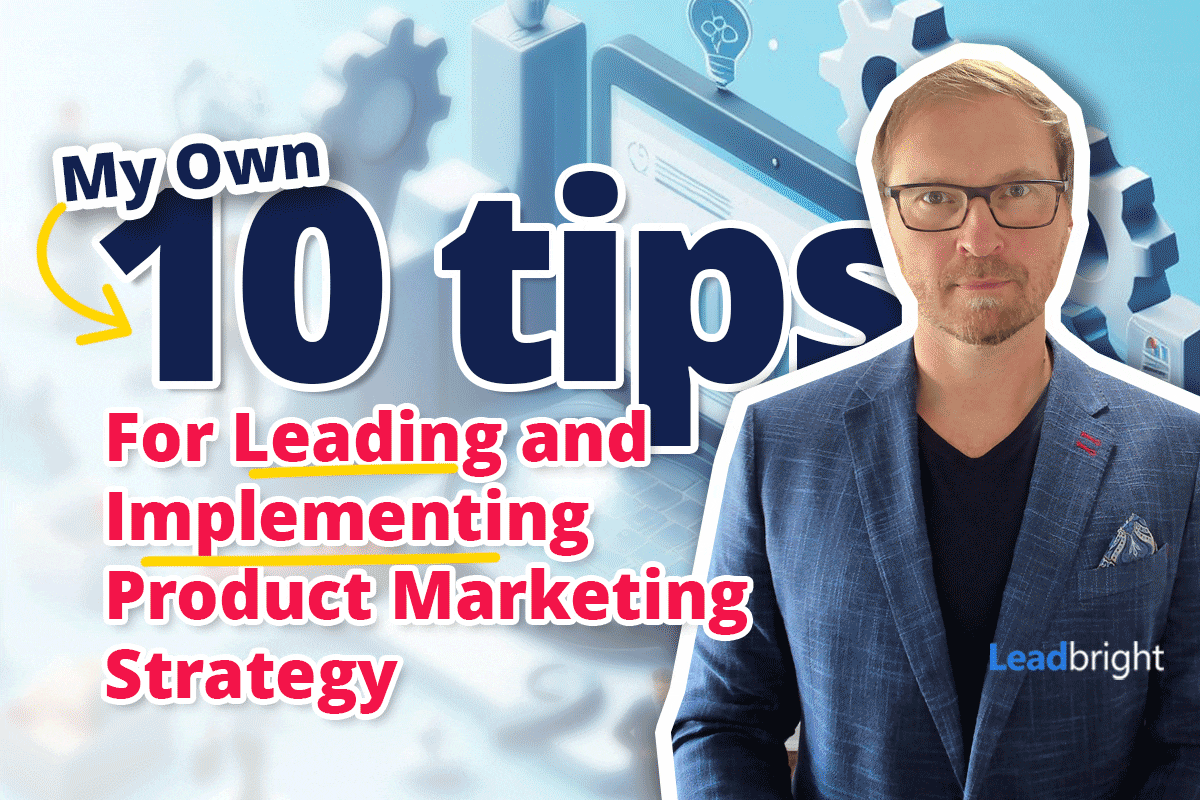8 Tips on Becoming a Strategic and Results Oriented Marketing Leader

From honing goal-setting skills to leveraging data, we’ll explore the multifaceted journey towards becoming a strategic, results-oriented marketing leader. Join us as we delve into this transformative process and unlock your potential for impactful leadership.
1. Understanding the Importance of Strategic Thinking
Amid the rapidly changing business environment, comprehending the importance of strategic thinking—characterized by the ability to anticipate, envision, and maintain flexibility—remains pivotal in driving organizational success. This process of strategic thinking involves analyzing competition, encouraging creativity, visionary leadership, scenario planning, and building resilience.
Analyzing competition is a critical aspect of strategic thinking. It enables us to understand the current market dynamics, identify potential threats, and develop strategies to overcome them. Encouraging creativity, on the other hand, allows for the development of innovative solutions to complex problems, fostering a culture of continuous improvement.
Visionary leadership is about seeing the bigger picture. It involves creating a compelling vision for the future, inspiring the team to work towards that vision, and making crucial decisions that shape the organization’s course. Scenario planning complements visionary leadership by anticipating various future possibilities and preparing for them, thereby building resilience in the face of uncertainties.
2. Developing Your Results-Oriented Mindset
To achieve sustainable success in today’s dynamic business landscape, it is essential to cultivate a results-oriented mindset, which emphasizes the importance of outcome over process. This mindset molding process is key to becoming a strategic and results-oriented marketing leader.
The first step is to adopt productivity hacks that refine decision making dynamics. It’s about making smart choices that lead to definitive results. This involves setting clear, achievable goals, and making decisions that align with these goals.
Self-motivation strategies play a huge role in this. Encourage yourself to strive for success, even in the face of adversity. This internal drive will keep you focused on the results, not the hurdles.
Emotional intelligence is equally vital in shaping your results-oriented mindset. It’s about understanding your emotions and those of others and using this understanding to guide your thoughts and actions. It significantly influences your decision making, enhancing both personal and professional relationships, and the results.
3. The Art of Goal Setting in Marketing Leadership
Both the formulation of strategic objectives and the precise setting of measurable goals constitute the art of goal setting in marketing leadership, which is a crucial factor for any organization’s success. This process begins with Goal Alignment – ensuring that each team member’s objectives are coordinated with the overarching goals of the organization.
Performance Metrics come in next, providing a tangible means to assess progress and effectiveness. These metrics should not only be quantifiable but also relevant to the specific goals set. Objective Prioritization is another fundamental aspect, ensuring that the most impactful goals are tackled first. This step is a delicate balancing act, which involves analyzing the potential impact versus the resources required.
Motivational Techniques play a significant role in goal setting. A motivated team is more likely to be engaged and committed to achieving set objectives. Techniques can vary, but the key is to foster an environment where everyone feels valued and understood.
4. Effective Team Management for Optimal Results
While the art of goal setting is indeed crucial, effective team management is equally important in steering a team towards optimal results. This requires embracing team diversity, mastering delegation techniques, and implementing robust conflict resolution strategies.
Team diversity is the backbone of innovation. A heterogeneous team brings together a multitude of perspectives and ideas, thereby fostering creativity and problem-solving. However, this diversity also necessitates the use of effective delegation techniques. These involve assigning tasks based on individual strengths and areas of expertise, while also considering the overall workload and capacity of the team.
Conflict, while inevitable in a diverse team, can be transformed into a productive force with the right conflict resolution strategies. Open communication, empathy, and a clear understanding of everyone’s viewpoint are key to resolving disagreements and maintaining harmony.
Performance metrics are indispensable tools in tracking progress and identifying areas for improvement. They provide an objective basis for feedback and recognition, thereby serving as powerful motivation strategies.
5. Leveraging Data for Strategic Decision Making
In my experience, leveraging data for strategic decision making is not only crucial for operational efficiency, but it also provides a competitive edge in the rapidly evolving business landscape. Data visualization, for instance, presents information in a digestible format, enabling decision-makers to quickly identify trends and patterns.
A perfect example is the use of predictive analytics. It empowers businesses to anticipate market trends, customer behavior, and potential risks. By utilizing such data driven strategies, companies can adapt their marketing and operations to suit predicted outcomes, thereby gaining an advantage over competitors.
However, we cannot ignore privacy concerns associated with data handling. It is essential to balance the quest for insights with the need to respect customer privacy. This is where customer segmentation comes into play. It groups customers based on shared characteristics, allowing targeted marketing without infringing on personal data.
Embracing a data-driven approach in strategic decision-making is like navigating through a dark room with a flashlight. It sheds light on the path to follow, the obstacles to avoid, and the opportunities to seize. It’s a powerful tool that, when used responsibly, can drive growth, efficiency, and innovation.
6. The Role of Innovation in Strategic Marketing Leadership
Before the advent of digital marketing, traditional methods dominated the scene, but today, the role of innovation in strategic marketing leadership has become paramount, driving meaningful change in the way businesses approach and execute their marketing strategies. The shift towards innovative, disruptive marketing has reconfigured the competitive landscape, with creativity cultivation being a key factor in setting a brand apart.
Innovation measurement has emerged as a critical tool for marketing leaders to gauge their progress. It provides insights into the effectiveness of novel strategies, allowing leaders to tweak and fine-tune their approaches for better results. In an intimate setting, it’s essential to understand and appreciate that innovation measurement isn’t just about numbers—it’s about understanding the story those numbers tell and using that information to create a compelling marketing narrative.
Disruptive marketing, which challenges the status quo, can provide a competitive advantage, especially in saturated markets. It requires a willingness to take risks and be different—an ethos that should permeate the entire organization. For businesses, innovation-driven success is no longer a bonus, but a necessity. Fostering an environment of creativity cultivation, therefore, must be a key priority for every strategic marketing leader.
7. Essential Communication Skills for Marketing Leaders
Effective listening and clear articulation form the backbone of essential communication skills for marketing leaders, and they play a crucial role in driving team collaboration, fostering creativity, and ensuring strategic alignment across the organization. In these intimate circles of professional discourse, there is a need for persuasive storytelling, a skill that helps marketing leaders paint a vivid picture of the company’s strategic vision.
Emotional intelligence, another critical skill, enables them to empathize with team members and clients alike, fostering a cohesive and customer-centric ethos. Active listening, often underestimated, is a fundamental skill that allows leaders to understand and respond effectively to their team, promoting a culture of open communication.
Non-verbal communication, such as body language and facial expressions, can often convey more than words, and astute marketing leaders are adept at interpreting these subtle cues. Lastly, the ability to give and receive constructive feedback is vital for continuous improvement and performance enhancement. This skill requires a delicate balance of honesty and tact, demonstrating respect for the individual while promoting the overall success of the team and organization. Hence, these communication skills are pivotal in shaping effective, strategic, and results-oriented marketing leaders.
8. Cultivating a Continuous Learning Environment
Cultivating a continuous learning environment requires a commitment to skill development, fostering a culture of intellectual curiosity that can drive both individual growth and organizational success. It’s a strategic move that hinges on embracing diverse learning methodologies. These methodologies can range from traditional classroom training to hands-on workshops to online learning platforms. They are designed to promote personal development and skill enhancement, shaping individuals into strategic and results-oriented leaders.
A feedback culture is a crucial component of this learning environment. It allows for real-time assessment and aids in refining the learning process. It’s not just about pointing out areas for improvement, but equally celebrating achievements and progress made. This culture of open communication nurtures trust, creating an intimate environment conducive to knowledge sharing.
Furthermore, knowledge sharing is an essential element in a continuous learning environment. It fosters a sense of community as individuals share their unique insights and experiences, enriching the overall learning experience. This culture of sharing and learning together ultimately aids in personal development and skill enhancement. Cultivating this environment is a strategic step in becoming a successful marketing leader.
Conclusion
In conclusion, the evolution into a strategic and results-oriented marketing leader requires a synthesis of strategic thinking, goal orientation, effective team management, data leverage, innovation, communication skills, and a continuous learning ethos. These components, symbolized as the gears of a well-oiled machine, must work in tandem to drive marketing success. Each gear, invaluable in its unique role, contributes to the collective rhythm and flow of effective leadership.



